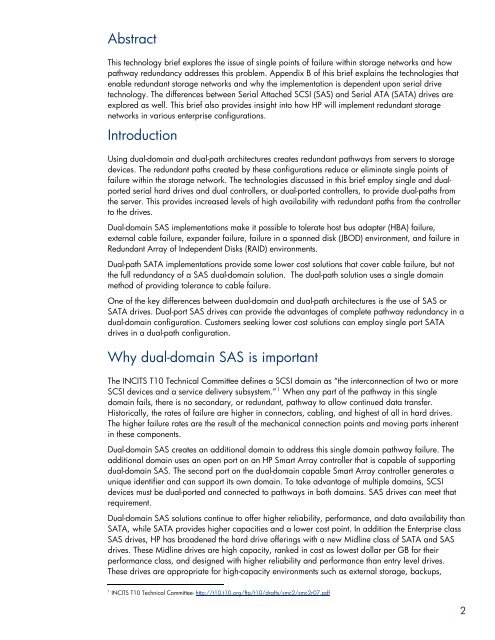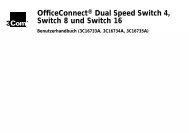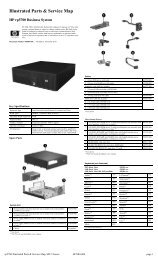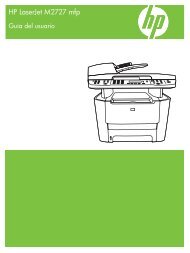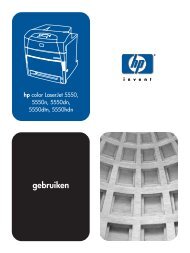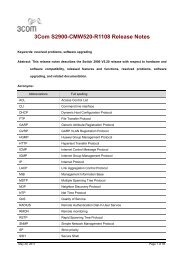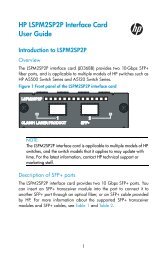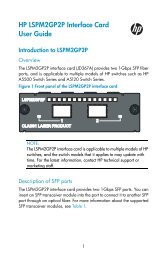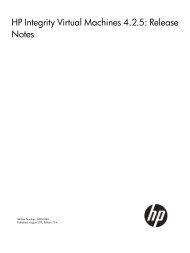Redundancy in enterprise storage networks using dual-domain SAS ...
Redundancy in enterprise storage networks using dual-domain SAS ...
Redundancy in enterprise storage networks using dual-domain SAS ...
You also want an ePaper? Increase the reach of your titles
YUMPU automatically turns print PDFs into web optimized ePapers that Google loves.
Abstract<br />
This technology brief explores the issue of s<strong>in</strong>gle po<strong>in</strong>ts of failure with<strong>in</strong> <strong>storage</strong> <strong>networks</strong> and how<br />
pathway redundancy addresses this problem. Appendix B of this brief expla<strong>in</strong>s the technologies that<br />
enable redundant <strong>storage</strong> <strong>networks</strong> and why the implementation is dependent upon serial drive<br />
technology. The differences between Serial Attached SCSI (<strong>SAS</strong>) and Serial ATA (SATA) drives are<br />
explored as well. This brief also provides <strong>in</strong>sight <strong>in</strong>to how HP will implement redundant <strong>storage</strong><br />
<strong>networks</strong> <strong>in</strong> various <strong>enterprise</strong> configurations.<br />
Introduction<br />
Us<strong>in</strong>g <strong>dual</strong>-doma<strong>in</strong> and <strong>dual</strong>-path architectures creates redundant pathways from servers to <strong>storage</strong><br />
devices. The redundant paths created by these configurations reduce or elim<strong>in</strong>ate s<strong>in</strong>gle po<strong>in</strong>ts of<br />
failure with<strong>in</strong> the <strong>storage</strong> network. The technologies discussed <strong>in</strong> this brief employ s<strong>in</strong>gle and <strong>dual</strong>ported<br />
serial hard drives and <strong>dual</strong> controllers, or <strong>dual</strong>-ported controllers, to provide <strong>dual</strong>-paths from<br />
the server. This provides <strong>in</strong>creased levels of high availability with redundant paths from the controller<br />
to the drives.<br />
Dual-doma<strong>in</strong> <strong>SAS</strong> implementations make it possible to tolerate host bus adapter (HBA) failure,<br />
external cable failure, expander failure, failure <strong>in</strong> a spanned disk (JBOD) environment, and failure <strong>in</strong><br />
Redundant Array of Independent Disks (RAID) environments.<br />
Dual-path SATA implementations provide some lower cost solutions that cover cable failure, but not<br />
the full redundancy of a <strong>SAS</strong> <strong>dual</strong>-doma<strong>in</strong> solution. The <strong>dual</strong>-path solution uses a s<strong>in</strong>gle doma<strong>in</strong><br />
method of provid<strong>in</strong>g tolerance to cable failure.<br />
One of the key differences between <strong>dual</strong>-doma<strong>in</strong> and <strong>dual</strong>-path architectures is the use of <strong>SAS</strong> or<br />
SATA drives. Dual-port <strong>SAS</strong> drives can provide the advantages of complete pathway redundancy <strong>in</strong> a<br />
<strong>dual</strong>-doma<strong>in</strong> configuration. Customers seek<strong>in</strong>g lower cost solutions can employ s<strong>in</strong>gle port SATA<br />
drives <strong>in</strong> a <strong>dual</strong>-path configuration.<br />
Why <strong>dual</strong>-doma<strong>in</strong> <strong>SAS</strong> is important<br />
The INCITS T10 Technical Committee def<strong>in</strong>es a SCSI doma<strong>in</strong> as “the <strong>in</strong>terconnection of two or more<br />
SCSI devices and a service delivery subsystem.” 1 When any part of the pathway <strong>in</strong> this s<strong>in</strong>gle<br />
doma<strong>in</strong> fails, there is no secondary, or redundant, pathway to allow cont<strong>in</strong>ued data transfer.<br />
Historically, the rates of failure are higher <strong>in</strong> connectors, cabl<strong>in</strong>g, and highest of all <strong>in</strong> hard drives.<br />
The higher failure rates are the result of the mechanical connection po<strong>in</strong>ts and mov<strong>in</strong>g parts <strong>in</strong>herent<br />
<strong>in</strong> these components.<br />
Dual-doma<strong>in</strong> <strong>SAS</strong> creates an additional doma<strong>in</strong> to address this s<strong>in</strong>gle doma<strong>in</strong> pathway failure. The<br />
additional doma<strong>in</strong> uses an open port on an HP Smart Array controller that is capable of support<strong>in</strong>g<br />
<strong>dual</strong>-doma<strong>in</strong> <strong>SAS</strong>. The second port on the <strong>dual</strong>-doma<strong>in</strong> capable Smart Array controller generates a<br />
unique identifier and can support its own doma<strong>in</strong>. To take advantage of multiple doma<strong>in</strong>s, SCSI<br />
devices must be <strong>dual</strong>-ported and connected to pathways <strong>in</strong> both doma<strong>in</strong>s. <strong>SAS</strong> drives can meet that<br />
requirement.<br />
Dual-doma<strong>in</strong> <strong>SAS</strong> solutions cont<strong>in</strong>ue to offer higher reliability, performance, and data availability than<br />
SATA, while SATA provides higher capacities and a lower cost po<strong>in</strong>t. In addition the Enterprise class<br />
<strong>SAS</strong> drives, HP has broadened the hard drive offer<strong>in</strong>gs with a new Midl<strong>in</strong>e class of SATA and <strong>SAS</strong><br />
drives. These Midl<strong>in</strong>e drives are high capacity, ranked <strong>in</strong> cost as lowest dollar per GB for their<br />
performance class, and designed with higher reliability and performance than entry level drives.<br />
These drives are appropriate for high-capacity environments such as external <strong>storage</strong>, backups,<br />
1 INCITS T10 Technical Committee- http://t10.t10.org/ftp/t10/drafts/smc2/smc2r07.pdf<br />
2


